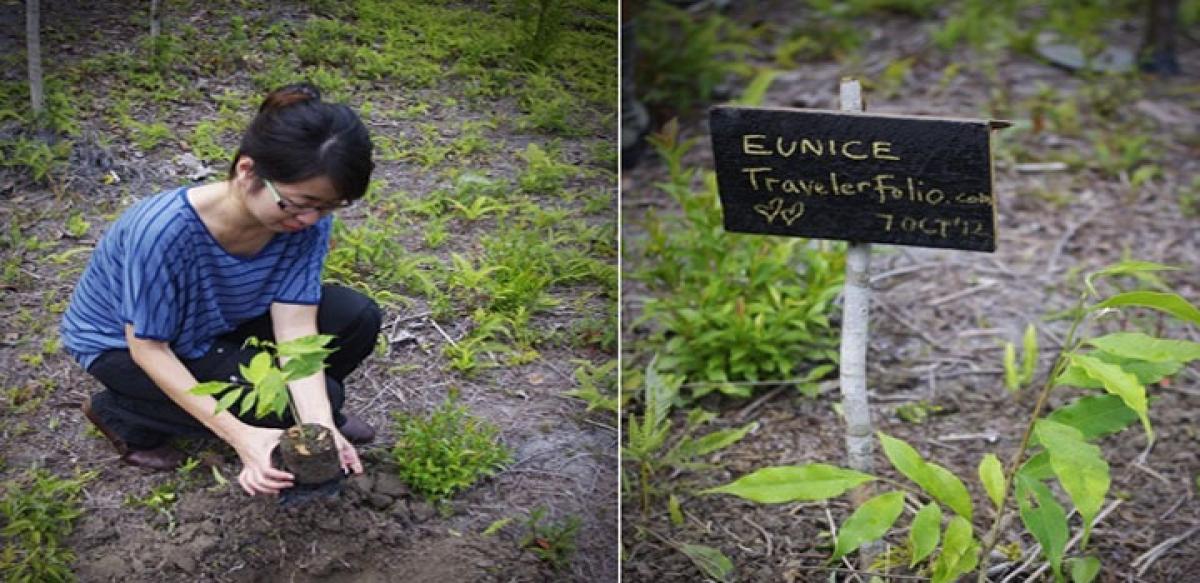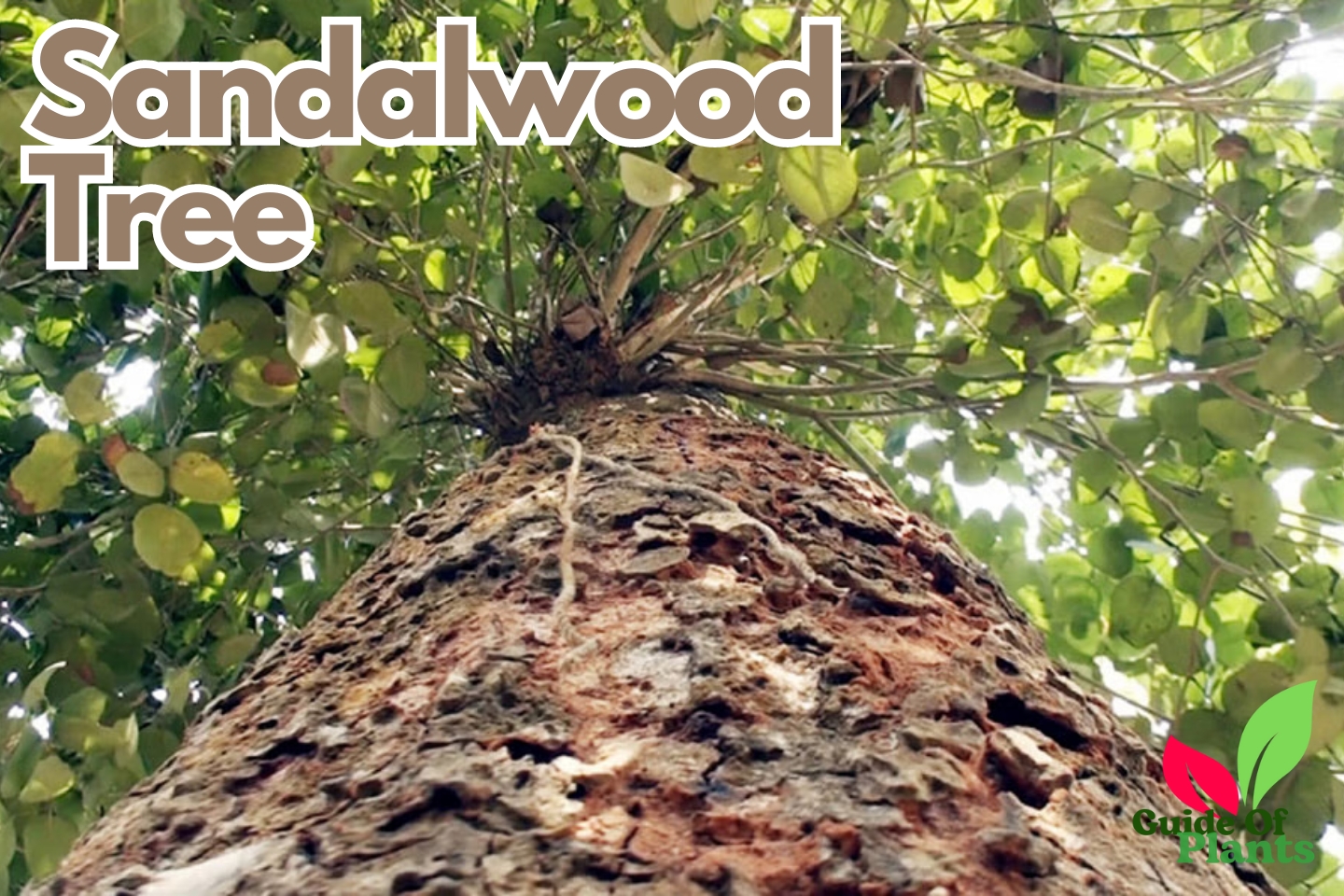Sandalwood refers to trees from the genus Santalum, which are medium-sized hemi parasitic evergreens known for their valuable fragrant wood. There are over 25 species, found across Asia, Australia, and islands in the Pacific. Sandalwood tree grow in tropical, subtropical, and semiarid regions. There are many different species of this tree. Most of them are native to India, Indonesia, Malaysia. Santalum also natively grows in Australia, Hawaii, and other parts of Oceania. They grow in relatively dry forests and woodlands.
Sandalwood tree can reach heights of 10-25 meters. They have thick greenish-gray foliage with slender drooping branches. The wood is yellowish and releases its distinctive fragrant aroma when cut. Small purple or green flowers bloom in clusters. Sandalwood has been used in traditional medicine, rituals, art, and religious ceremonies for centuries, especially in Hinduism and Buddhism. The essential oil and aromatic wood is highly valued. This causes overhear growing in some regions.
Table of Contents
Also Know About:
- Discover The 3 Main Types of Forest Trees You Must Know
- Nepenthes Alata, Nature’s Old Secrets of The Carnivorous Adaptation
- The Silk Floss Tree, Nature’s Remarkable Gift To Life
Biology of Sandalwood Trees
The most commonly known sandalwood is Santalum album, native to India. There are however several other Santalum species found across Asia, Australia, and the Pacific islands. Each has unique genetics, but all produce the valued sandalwood oil. Santalum trees are part of the larger Santalaceae family, which contains other parasitic species.
Sandalwood trees have a light-colored wood with a fine, close grain. The heartwood is the most prized part, being heavy, yellow, and high in essential oil content. Leaves are evergreen, thick, green to gray-green in color. Small flowers bloom in clusters and are purple or green-yellow. Roots lack root hairs and form connections with host plants.
Sandalwood is semi-parasitic, meaning it derives water and nutrients by tapping into the roots of other plants. The trees flower after 7-15 years, and are pollinated by insects or birds. Seeds take 15-20 months to mature. Trees can live 50-100 years.
Seedlings and young sandalwood trees grow slowly. Heartwood formation accelerates between 15-30 years of age. Trees are typically harvested between 30-80 years old, when oil content peaks. Lifespan depends on genetics and growing conditions.

Sandalwood Tree Ecology
Sandalwood trees grow in tropical, subtropical, and semi-arid environments. This tree prefers relatively dry conditions. Naturally it needs rainfall between 500-1500 mm annually for better growth. Temperatures between 18-35°C are optimal. Sandalwood grows best in well-drained, acidic, sandy soils. The trees cannot tolerate water logging or saline conditions. Elevation ranges from sea level up to 1,500 meters.
Various Santalum species occur naturally across southern Asia, islands in the Pacific Ocean, and Australia. The native range stretches from India and Nepal, east to Hawaii and the Marquesas. Different species are found in specific regions:
- S. album – India, Indonesia, Malaysia
- S. lanceolatum – Australia
- S. paniculatum – Hawaii, Tahiti
- S. spicatum – Western Australia
- S. yasi – Vanuatu, Fiji
Symbiotic Relationships
Sandalwood exhibits hemi parasitism, tapping into the roots of other plants for water and nutrients, especially nitrogen. Common host species include Acacia, Cassia, and a number of Shrubs and Grasses. The hyphae connections do not kill the host. Birds, bats, insects aid in pollination.
- Pests, Diseases, and Predators: Sandalwood trees face damage from fungal diseases like leaf spot, stem canker, and heart rot. Insect pests include mirid bugs, aphids, beetles, and mites. Rodents gnaw on roots and stems. Overgrazing, land clearing, and lack of hosts impact growth.
- Conservation Status and Threats: Overharvesting for sandalwood oil has led to a decrease in natural stands. S. album is classified as Vulnerable, while S. spicatum is Endangered. Illegal logging, forest clearing, and lack of natural regeneration hinder recovery. Reforestation efforts focus on replanting seedlings and saplings into protected reserves.

Uses and Cultivation of Sandalwood Trees
For centuries, sandalwood tree has been highly valued in daily life use. Many traditional medicines, rituals, ceremonies, and art are made by it across Asia and the Pacific islands. The fragrant wood and oil is integral to many Hindu, Buddhist, and Jain practices. Sandalwood paste and oil are used to anoint religious idols, artifacts, and temple walls. The wood is carved into prayer beads and burned as incense sticks. Sandalwood essential oil has been used in Ayurvedic medicine to treat skin and mental health conditions. Many cultures incorporate sandalwood into wedding rituals, funerals, and spiritual healing.
Today, sandalwood remains an important ingredient. It is used in perfumes, cosmetics, soaps, candles, and aromatherapy products. The essential oil contains over 300 chemical compounds that give it a woody, sweet, balsamic scent. Sandalwood oil is extracted through steam distillation of wood chips and remains very expensive. The fine-grained yellowish heartwood is also used to make luxury furniture, carvings, and handicrafts. There is growing use of sandalwood powder and oil in the food and beverage industry for flavoring.
Because of overexploitation, many efforts are going to grow sandalwood trees on plantations and in agroforestry systems. Propagation is done via seeds, cuttings or tissue culture. Seedlings benefit from partial shade and require hosts once established. Drip irrigation and organic fertilizers boost growth. Slow-release capsules containing herbicide protect young trees from surrounding vegetation. Pests like stem borers can be controlled with pheromone traps and avoidance of monocultures. Trees are typically harvested in 25-30 years.
Mature sandalwood trees should only be selectively harvested during the non-seeding season. Cutting large, healthy specimens disrupts regeneration and is avoided. Smaller trees and dead/dying wood are targeted first. The stump and root billets are extracted to maximize oil yield. In India, 2-5% of trees may be harvested annually. Old cultivated trees are felled while some are retained for seed. Illegal logging remains an issue in some regions.
Several initiatives aim to replenish wild sandalwood populations through planting seedlings and saplings within government forest reserves. Natural hosts are encouraged to proliferate. Strict protection laws have been enacted. Public awareness campaigns educate on the ecological importance of sandalwood. More research is needed to improve plantation practices and sandalwood conservation globally.
Importance of Sandalwood Today
The global market for sandalwood products is estimated at over $1 billion. Sandalwood cultivation and sale provides income for many rural communities. However, illegal logging and poaching are still issues in countries like India and Indonesia. Rising prices have led to the adulteration of oil. More certification and fair trade initiatives are needed to ensure sustainability. The development of synthetic sandalwood compounds may impact future demand and supply dynamics.

- Ecological Role: As hemiparasites, sandalwood trees form vital associations with neighboring vegetation in dry tropical forests. They aid in nutrient cycling and seed dispersal. Sandalwood helps maintain understory diversity and benefits other symbiotic species. Depletion can degrade habitats and allow invasive plants to dominate. Reforestation aims to restore balance in affected ecosystems like Hawaii’s sandalwood forests. Climate change may alter future distribution and viability.
- Cultural and Religious Value: Sandalwood remains an integral part of spiritual traditions and cultural heritage across Asia and the Pacific. The aromatic wood and oil are still used in ceremonies, festivals, prayers, medicine, and art. However, some traditional uses have declined due to scarcity and cost of high-quality sandalwood. Public education and stronger heritage protection policies can help preserve sandalwood’s non-commercial values.
- Conservation Efforts: Most wild sandalwood populations are threatened by overexploitation. All international trade is regulated under CITES. Several countries have imposed protection laws, logging bans, and limits on harvest. Forest restoration, host planting, and community monitoring aim to stabilize numbers. More effective enforcement, habitat management, and sustainable forestry methods are required to conserve natural stands.
- Future Sustainability: The survival of sandalwood ultimately depends on a multifaceted approach – strong legal protection, responsible cultivation, ethical production practices, scaled-up reforestation, and reduced consumer demand. Research to boost productivity, fight pests, and develop synthetic substitutes also plays a role. With coordinated efforts, sandalwood can persist as an ecologically vital and culturally significant tree.

Conclusion
In summary, sandalwood trees are a unique and increasingly endangered group of species valued for their aromatic wood and oil. There are over 25 Santalum species across Asia, Australia, and the Pacific islands that have adapted to dry tropical forests. Sandalwood has a long history of cultural, religious, medicinal and commercial use spanning centuries.
However, overexploitation has led to depleted natural populations of sandalwood in many regions. Most species now face extinction risks and are regulated under CITES. Sandalwood provides ecological benefits in its native habitats and plays a key role in certain cultures. More responsible cultivation, sustainable forestry methods, and habitat restoration are crucial for preserving sandalwood.
While sandalwood plantations, agroforestry and reforestation initiatives are expanding, they cannot fully replace diverse natural stands. Sandalwood trees warrant stronger legal protection and conservation both in protected wilderness areas as well as on private and communal lands. Public education and awareness campaigns can also encourage mindful use of sandalwood products.
In conclusion, coordinated efforts between governments, local communities, researchers and industry stakeholders are needed to ensure the survival of sandalwood forests. The preservation of these tree remains a key challenge for the 21st century.




